Abstract
Encouraging the usage of new energy vehicles (NEVs) in big cities is not only a key area of priority for the government to encourage the transformation of the automobile industry, but it is also a crucial step in reducing environmental pollution. Big cities commonly limit the number of cars because they lack the resources and space to accommodate new vehicles. A crucial policy to reduce the number of cars in metropolitan areas is the license plate auction policy. Therefore, considering the fuel vehicle (FV)’s license plate auction policy, this study investigated the effects of the subsidy policy and the dual-credit policy on the production decisions of NEVs and FVs manufacturers. A competitive game model was constructed that considered NEV and FV manufacturers and accounted for consumer environmental awareness. The manufacturer’s optimal production decision was analyzed in four different scenarios—no government intervention, a license plate auction policy, a subsidy policy based on license plate auction policy, and a dual-credit policy based on the license plate auction policy. The results suggested that the manufacturer’s profit will be significantly higher in the absence of a license plate auction policy than in the presence of one. In other words, both NEV and FV manufacturers will suffer as a result of license plate restriction. Additionally, improvements in consumer environmental awareness, government subsidies, and credit cost/benefit ratios will improve the weak position of NEV manufacturers following the introduction of a license plate auction.
1. Introduction
As the pace of urbanization accelerates, metropolises have incrementally become the most prominent hub of resource and environmental problems [1,2]. At present, several big cities in China encounter some common issues, e.g., loss of ecological resources, air pollution, and traffic congestion. Moreover, preventing air pollution constitutes a core issue of sustainable development in the Chinese metropolis. In megacities such as Beijing, Shanghai, and Hangzhou, motor vehicle emissions are the primary source of air pollution, according to the Annual Report on Environmental Management of Motor Vehicles in China [3]. As a result, many megacities have enacted legislation to encourage a decrease in car emissions.
Increasing the NEVs population has been the top priority for local governments because it may reduce environmental pollution, fuel consumption, and energy security [4,5]. To this goal, local governments in cities such as Beijing and Shanghai have granted local subsidies based on central fiscal subsidies to promote the purchase of NEVs. As a result, from 2010 to 2017, the percentage of NEVs in these megacities doubled yearly (see Figure 1). High subsidies have, however, encouraged many small- and medium-sized automakers to engage in subsidy fraud [6]. Government subsidies have steadily decreased in order to address this issue. Subsequently, the Chinese Central Government introduced “Parallel Management Measures for Average Fuel Consumption and New Energy Vehicle Credits of Passenger Enterprises” in 2017, which is also known as “dual-credit policy”. This policy employs a credits-based system of rewards and penalties to discourage the development of fuel vehicles (FVs) and encourage the development of NEVs.

Figure 1.
The car parc rate of NEVs from 2010 to 2020 in China’s megacities (Note: the line chart uses the right longitudinal axis, whereas the histogram uses the left longitudinal axis).
Prior policy research has examined the effects of financial subsidies and dual-credit policy (e.g., Zhang et al. [7], Zhang and Cai [8], Li et al. [9]). These two policies promote the development of NEVs by incentivizing NEV manufacturers to produce (the goal is to adjust industrial structure) or consumers to purchase (the goal is to stimulate demand). However, these studies ignore the urban milieu factors in the areas where these policies are implemented, meaning that the conclusions may be biased. The price of acquiring a license plate is one of the significant environmental elements influencing the demand for cars in Chinese cities. Currently, eight Chinese metropolises—Beijing (2011), Shanghai (1986), Guangzhou (2012), Guiyang (2011), Tianjin (2013), Hangzhou (2014), Shenzhen (2014), and Hainan (2018)—restrict licensing for FVs. For instance, the bidding success rate for FV license plates is only 5–6% in Shanghai. NEVs license plates, however, are exempt from this restriction, and six metropolises rank at the forefront of China’s NEVs sales. Beijing and Shanghai, China’s two largest cities and the places where the license plate restriction was first implemented, accounted for up to 30% of all NEV sales in 2016 (see Figure 2). Generally, the preferential license plate restriction policy may be the primary factor encouraging consumer demand for NEV purchases in megacities [10]. Zhang, Bai, and Zhong [10] conducted an empirical investigation into how Beijing’s license plate lottery policy affected consumers’ decisions to buy NEVs. In this policy, consumers must enter a separate lottery to obtain a FV license plate. However, compared to the license plate lottery policy, the “auction” bidding policy for license plates is used in many Chinese cities, including Shanghai, Shenzhen, Guangzhou, Hangzhou, etc. This policy can guarantee that buyers who are willing to pay a high enough price will get a license plate. To our knowledge, the impact of this policy on NEVs has not been explored.
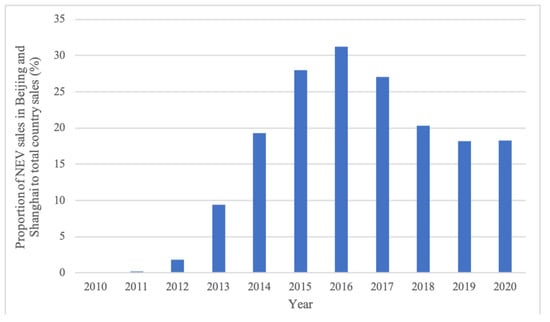
Figure 2.
The ownership of NEVs from 2010 to 2020 in Beijing and Shanghai.
The aforementioned explanations provide the motivation for additional research into the metropolitan-specific license plate auction policy and its effects on the dual-credits and subsidy policies. To enable participants to form their own strategies based on the expectation of short-term profit maximization and anticipating the conduct of other players [11,12], game theory is widely utilized in the modeling of competitive relationships among several subjects and the analysis of policy effects (e.g., Li, Ku, Liu and Zhou [9], Lou et al. [13]). In order to analyze government policy and consider the partial competition and substitution relationship between FVs and NEVs, this study constructed a game model for the analysis to answer the following questions:
- (1)
- What is the equilibrium pricing of FVs and NEVs under the license plate auction policy?
- (2)
- What impact does the license plate auction policy have on the dual-credit and subsidy policies?
- (3)
- How do various policies affect NEVs’ green innovation rate?
- (4)
- How are manufacturers’ decisions impacted by consumers’ environmental awareness in different policy settings?
In order to answer the above questions, this study explored the manufacturer’s pricing problem in the competitive environment of FVs and NEVs. Four policy situations were examined: no government intervention, only license plate auction policy, subsidy policy based on license plate auction policy, and dual-credit policy based on license plate auction policy. The contributions of this paper are as follows: (1) Empirical approaches have been the mainstay of prior studies on the license plate restriction policy, such as Chen and Zhao [14] and Zhang, Bai, and Zhong [10]. Based on game theory, this study constructed a new FV demand function that depends not only on consumer environmental awareness, but also on the acquisition cost of its license plate. It expands the application scenarios of game theory. (2) Previous empirical studies have mainly addressed how the license plate restriction policy affects the demand for NEVs, but they do not involve the optimal production decision analysis of automakers. This study analyzed the impact of the FV’s license plate auction policy on the production of NEV and FV manufacturers. As a result, this research adds to the body of knowledge on decision making and policy in the automobile industry. (3) The effects of other environmental or policy factors have not been considered in prior studies on subsidy policy or dual-credit policy. This study analyzed the joint effects of the FV’s license plate auction with financial subsidy and dual-credit policy on automakers. It also further enriches the policy research on NEVs.
The remainder of the paper is organized as follows. Section 2 reviews related research. Section 3 describes the issue and its corresponding notation and assumptions. Mathematical models, as well as the solution approaches, are presented in Section 4. The comparison of the equilibrium results is presented in Section 5. Section 6 presents the numerical results. Section 7 concludes the study and highlights related managerial implications and further research directions.
2. Literature Review
Our study mainly relates to the following streams of research: financial subsidy, dual-credit policy, and license plate restriction policy. These policies have had a tremendous impact on the development of China’s automotive sector.
2.1. Financial Subsidy Policy
The implementation of financial subsidies has greatly facilitated the development of NEVs in China [15,16]. Financial subsidies have a lower expenditure than the price discount policy for the government [17]. They can also solve the problem of high technological costs and battery costs in the initial development of the NEV industry [18]. This policy has been examined in a sizable number of studies from distinct viewpoints. For the subsidy object, Yang et al. [19] found that consumer subsidies can produce a higher level of social welfare for the subsidy object than manufacturer subsidies.
Moreover, there are also reports in the literature on countermeasures for the decline of financial subsidies. Yang et al. [20] used a two-level Stackelberg game to study the pricing strategy of NEV sharing under government subsidies. The results showed that implementing reasonable price subsidies for shared NEVs can achieve the best collective interests. To some extent, this helps to lessen the effects of the reduction in private NEV subsidies. Chen et al. [21] found that government subsidies still play an imperative role in the transition period of subsidy decline; they support each other and the dual-credit strategy in encouraging technological innovation in businesses.
2.2. Dual Credit Policy
A dual-credit policy was implemented to reduce the financial pressure on the government and the occurrence of subsidy fraud behaviors. The so-called dual credit is: Corporate Average Fuel Consumption (CAFC) credit rules, that is, negative credits, and NEV credit rules, also called positive credits. According to this strategy, automakers will be penalized and forbidden from producing high-fuel-consumption cars if no or not enough NEVs are created (i.e., they will produce “negative credits”). FV manufacturers can purchase positive credits from other NEV manufacturers to offset their negative credits if they do not wish to halt production due to bad debt. Essentially, it is equivalent to a production subsidy for NEV manufacturers with fines for FV manufacturers.
Several scholars have studied the effects of the dual-credit policy. Li et al. [22] formulated a multiperiod credit market dynamic equilibrium model to reflect NEV production, credit performance, and the profits of automakers. The results showed that increasingly stringent credit requirements for NEVs can slow the growth of internal combustion engine vehicle production and promote the substantial growth of NEVs. However, Lou, Ma, Fan, and Chan [13] arrived at the opposite conclusion. They established a decision-making model for the improvement of diesel locomotive fuel economy and output optimization under the dual-credit policy, in order to explore the impact of this policy on the enterprise level. Their results indicated that the implementation of the dual-credit policy may not help automakers improve the fuel economy of diesel locomotives or reduce the production of high-fuel consumption vehicles. Li, Ku, Liu, and Zhou [9] studied the impact of subsidy and dual-credit policy on the production decisions of NEVs and FVs manufacturers considering battery recycling. They found that only under the dual-credit policy could the improvement of the battery recycling rate induce the greatest demand spillover effect. Li et al. [23] further studied the situation of this issue in the context of cooperation and a competitive market. Their simulation showed that the production schedule of FVs/NEVs without across-chain cooperation is arranged more evenly than that with across-chain cooperation during the transition period to NEVs. Cheng and Fan [24] only investigated the strategic choices in production between competition and coopetition for an FV manufacturer and a NEV manufacturer under the dual-credit policy. Their results showed that cooperation in credit trading rather than competition in production is the optimal strategy. Moreover, for the dual-credit policy, maintaining a relatively high credit price is more conducive to promoting the expansion of NEVs than setting a high production ratio of NEVs.
2.3. License Plate Restriction Policy
By limiting the registration of new license plates, the license plate restriction policy regulates automobile ownership. Singapore was the first city to introduce license plate restrictions, and Tan [25] was the first to analyze the policy’s pros and cons in the country. According to the policy, consumers could obtain license plates through market auctions or a lottery. Chen and Zhao [14] used survey data from 524 employees of nine companies in Shanghai and found that respondents believed that Shanghai’s license plate auction policy was more influential in controlling the number of vehicles than parking fees and fuel taxes. Yang et al. [26] and Yang et al. [27] also believed that this policy could swiftly reduce the registration and use of new cars. Contrary to Chen and Zhao [14], Xiao et al. [28] analyzed Shanghai’s license plate auction policy and found that it was not as effective as the tax policy in controlling the number of vehicles. Zhang, Bai, and Zhong [10] compared license plate lottery and subsidy policies impact on consumers’ purchase intention. Through the analysis of a large number of sample data in Beijing, license plate lottery and subsidy policies were found to be the main factors affecting the promotion of electric vehicles in Beijing. In a certain sense, the impact of the license plate lottery policy is greater than the subsidy policy.
2.4. Resesrch Gap
Previous game theory studies have thoroughly examined the two primary promotion strategies for NEVs: the subsidy and the dual-credit policy. This study is more closely related to the studies of Cheng and Fan [24] and Li, Ku, Liu, and Zhou [9]. Cheng and Fan [24] examined the competitive strategies of an FV automaker and a NEV automaker under the dual-credit policy, but they overlooked the effect of consumer environmental awareness. Additionally, Li, Ku, Liu, and Zhou [9] contrasted the dual-credit and subsidy policies in a competitive environment. Their study mainly concentrated on the overall national level, rather than discussing specific varied metropolitan contexts. The implications of license plate restrictions on the manufacturing of NEVs were not taken into account.
The license plate restriction policy, particularly the license plate auction policy, has not been properly examined in previous game theory research. The license plate restriction policy could undoubtedly have an impact on the choices made by automakers in a market that is highly competitive, as a means of adjusting the connection between supply and demand. The use of game theory as a tool for decision making to resolve participants’ competing decisions [29] provided a unique perspective for this paper’s investigation of the license plate restriction policy. Table 1 presents a comparison that places our study in the context of the existing literature.

Table 1.
The main literature related to this research based on game theory.
3. Problem Description and Assumption
This study presents a single NEV manufacturer and a single FV manufacturer, both partially substitutable, engaged in Cournot competition in the vehicle market. NEVs have a lesser environmental impact than FVs. As a result, consumers who are more environmentally aware are more likely to buy NEVs. Governments are significant market participants who moderately control the overall number of cars in the context of large cities. The local government issues a specific number of license plates each year for the purchase of FVs in an effort to modestly restrict the overall number of vehicles. Greater demand exists for license plates than the total quantity of license plates issued (that is, the demand for purchasing FVs in that year). FV consumers must purchase license plates through a market auction, and the participating price is the market price. In addition, to promote the production of NEVs, the local government in this study has mainly adopted subsidy policy and dual-credit policy. In the subsidy policy, the government provides financial support to NEV manufacturers. In the dual-credit policy, NEV manufacturers earn income by selling NEV credits to FV manufacturers through the credit market. If the NEV credits are insufficient or the actual average fuel consumption level is higher than the national standard, FV manufacturers must purchase NEV credits to produce FVs. We considered two automakers’ production strategies in four scenarios: no government intervention (N), only license plate auction policy (M), subsidy policy based on license plate auction policy (S), and dual-credit based on license plate auction policy (D). The structure of the M, S, and D models is shown in Figure 3.
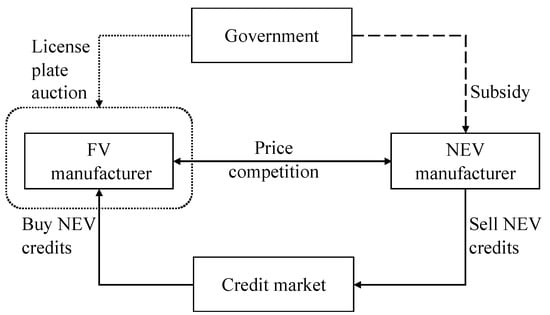
Figure 3.
Model structure under three policies.
Due to their competitive manufacturing strategies, the two manufacturers compete on price by simultaneously setting their production prices. Each party makes strategic judgments based on the other’s choices in order to maximize their earnings. Both parties are economically rational.
3.1. Demand
According to the study of Choi [34] and Liu et al. [35], this study adopted the linear inverse demand function. Therefore, the demand functions of FVs and NEVs are as below:
where is the potential demand for automobiles; is the potential demand for FVs; is the consumers’ environmental awareness; is the acquisition cost of a license plate; () is the green innovation rate of NEVs; represents the substitutability of the two automobiles; and and are the prices of a NEV and an FV, respectively.
3.2. The Profits of Manufacturer
NEV and FV manufacturers both pursue profit maximization. In line with Tsay and Agrawal [36] and Swami and Shah [37], assuming that the green innovation cost of a NEV is , is the green innovation cost coefficient of the NEV manufacturer. Therefore, the total profits of NEV and FV manufacturers are shown in Formulas (3) and (4).
When the government implements a subsidy policy, the total profits of NEV and FV manufacturers are shown in Formulas (5) and (6).
where is the subsidy per car. Under the dual-credit policy, automakers bear additional costs and benefits. For FV manufacturers, a predetermined number of NEV credits must be purchased for each FV produced, and because the average fuel consumption of the FV produced is higher than the national standard, more NEV credits must be obtained. Therefore, on the basis of Cheng and Fan [24], to simplify the calculation, this study took to represent the extra credit benefits by producing a NEV, and as an extra credit cost to produce a FV. is the conversion ratio of NEV credit benefits and FV credit costs. Hence, the total profits of the manufacturers are shown in Formulas (7) and (8).
3.3. Modeling of License Plate Auction Policy
This study refers to the research of Che et al. [38] to model the market auction of license plates, assuming that the license plate auction policy is specifically an auction system. The total amount of the license plate is . Since an FV is equipped with only one license plate, the total budget for purchasing the license plate is ; after obtaining the license plate, the utility value obtained by using the license plate is . They are distributed independently over and , according to the cumulative distribution functions, and , respectively. It is assumed that the demander’s budget level and utility value are independent, and there is no mutual influence between the two. If , ; otherwise, , . If , ; otherwise, , . Only the demand for which both the budget and the utility value are above the equilibrium price obtains a license plate, presuming that the equilibrium price is simultaneously determined by the budget level and the utility value, that is, and .
Hence, there is a unique market-clearing price , such that
We assume that both and obey a uniform distribution. By solving Equation (9), we get the price of license plates:
All the notations are defined and explained in Table 2.

Table 2.
Description of variable.
4. Models
In this section, we solve the models established based on the above assumptions and analysis, then analyze the results for the four policies.
4.1. No Intervention (N)
In this scenario, the government does not implement any policies on automakers. Hence, consistent with the above assumptions, the total profits of NEV and FV manufacturers are shown in Formulas (11) and (12).
Using the backward induction method, we can derive Theorem 1.
Theorem 1.
Under no intervention, if , we obtain the following equilibrium decisions:
otherwise, there is no optimal value that can maximize the profits of NEV and FV manufacturers.
See Appendix A for Proof. Note that H1–H5 parameters are presented in Appendix B.
Proposition 1.
When the consumers’ environmental awareness, τ, increases, the FV’s price, demand, and profit decrease, and the NEV’s price, greenness, demand, and profits increase.
All the proofs are presented in Appendix C. Consumers are more prepared to pay more for NEVs as their environmental awareness increases. This promotes the innovation and production enthusiasm of NEV manufacturers and increases their confidence in the NEV market, thereby promoting an increase in production. As a result, the profits of NEV manufacturers increase. FV manufacturers are the opposite of NEVs. This is consistent with the result of Li, Ku, Liu, and Zhou [9].
4.2. Only License Plate Auction Policy (M)
In this scenario, the government only implement license plate restriction policy on FVs. Hence, the total profits of NEV and FV manufacturers are shown in Formulas (16) and (17).
Following the principle of utility maximization, we solved Formulas (16) and (17) in the same way as Formulas (11) and (12). From Equations (16) to (17), using backward induction, we can derive Theorem 2.
Theorem 2.
Under license plate auction-only policy, if , we obtain the following equilibrium decisions:
otherwise, there is no optimal value that can maximize the profits of NEV and FV manufacturers.
See Appendix A for Proof. Note that H1–H7 parameters are presented in Appendix B.
Proposition 2.
- (1)
- When the total number of FV license plate issued, n, increases, both the FV’s price, demand, profit and the NEV’s price, green innovation rate, demand, and profits will increase.
- (2)
- .
All the proofs are presented in Appendix C. The local government’s license plate market quota will positively impact both NEV and FV manufacturers’ prices, greenness, demand, and profits. Thus, the more stringent the local government’s restrictions, the better for the overall management of the number of cars. Furthermore, as expected, license constraints have had a more detrimental effect on FVs. This is consistent with Ma et al. [39]. Moreover, due to the competition between FVs and NEVs, the government’s license plate restrictions also have a negative impact on NEVs. NEVs are negatively affected by license plate restriction because of the competition between FVs and NEVs. Acquiring a license plate raises the cost of owning an FV, which certainly lowers their demand. In order to remain competitive, FV manufacturers must reduce their pricing. Since FVs and NEVs compete with one another, decreasing the price of FVs will harm NEV sales; therefore, to be more competitive, NEVs must also lower their prices.
4.3. Subsidy Based on License Plate Auction Policy (S)
In this scenario, the government only implements financial subsidies and license plate auction policies on NEV manufacturers. Hence, the total profits of NEV and FV manufacturers are shown in Formulas (21) and (22).
We solved Formulas (21) and (22) in the same way as Formulas (11) and (12). From Equations (21) to (22), using backward induction, we can derive Theorem 3.
Theorem 3.
Under the subsidy with the license plate auction policy, if , we obtain the following equilibrium decisions:
otherwise, there is no optimal value that can maximize the profits of NEV and FV manufacturers.
See Appendix A for Proof. Note that H1–H7 parameters are presented in Appendix B.
Proposition 3.
When the subsidy of NEV manufacturers, s, increases, the FV’s price, demand, and profit decrease; in turn, the NEV’s price decreases, and the greenness, demand, and profits increase.
All the proofs are presented in Appendix C. With the increase in NEV subsidy, both FV and NEV manufacturers lower their prices, but NEV demand rises while FV demand falls. Due to this, NEV manufacturers’ earnings climb while FV manufacturers’ profits fall. Additionally, as in the research results of Meng et al. [40], the growth in NEV subsidy may encourage the NEV’s rate of green innovation.
4.4. Duel-Credit Based on License Plate Auction Policy (D)
In this scenario, the government implements the dual-credit and license plate auction policies on manufacturers. Hence, the total profits of NEV and FV manufacturers are shown in Formulas (26) and (27).
We solved Formulas (27) and (28) in the same way as Formulas (11) and (12). Then, we obtained the optimal solutions of NEV and FV, as in Theorem 4.
Theorem 4.
When the dual-credit policy and the license plate auction policy are implemented, if , we obtain the following equilibrium decisions:
otherwise, there is no optimal value that can maximize the profits of NEV and FV manufacturers.
See Appendix A for Proof. Note that H1–H7 parameters are presented in Appendix B.
Proposition 4.
- (1)
- When the conversion ratio of NEV credit benefits and FV credit costs b, it increases the NEV’s prices, demands, greenness, and profits and the FV’s prices, and profits will increase, but the FV’s demand will decrease.
- (2)
- .
All the proofs are presented in Appendix C. The costs of FV manufacturers rise when the conversion ratio of credit benefits and credit costs rises. FV manufacturers increase prices to avoid bankruptcy. Consumer demand for FVs declines. As a result, NEV manufacturers proportionately increase their prices in order to further increase profits. However, the price growth of NEVs is lower than FVs. NEV manufacturers can receive extra NEV credit benefits, providing them with more funds to boost innovation and increase production.
5. Analytical Analysis and Comparisons
This section presents the analysis of variables and the comparison of equilibria results and profits under various policies.
5.1. Parametric Analysis
5.1.1. Effect of the
Proposition 5.
When, , , ; when , , , .
All the proofs are presented in Appendix C. In the four scenarios, consumer environmental consciousness positively impacts the price and rate of green innovation for NEVs but has a negative impact on FVs. In addition, regardless of the kind of policy intervention, it diminishes the impact of consumer environmental awareness on pricing and green innovation rate.
5.1.2. Effect of the n
Proposition 6.
The effects of n on NEV’s price, green innovation rate, and profit are identical in all three scenarios, and they are all positive, that is, , , .
All the proofs are presented in Appendix C. It can be seen from Proposition 6 that under the three different policy scenarios, the number of government licenses issued has the same impact on the manufacturer’s optimal decision making, and both increase with the increase in the number of licenses issued.
5.2. Equilibria Analysis
In this section, the equilibrium solutions of the four scenarios are analytically investigated.
Proposition 7.
Whenever , , .
As can be seen from Proposition 7, automakers can only achieve higher pricing and production volumes without government intervention. Compared with the license plate auction only policy, the manufacturer’s pricing is lower under the subsidy policy based on the license plate auction. It shows that the punitive strategy of the license plate auction policy on the cost increase of FVs and the promotion strategy of the subsidy policy on the cost reduction of NEVs can simultaneously reduce consumers’ price expectations. However, the subsidy policy based on the license plate auction policy can encourage consumers to buy NEVs, while their desire to buy FVs is weaker.
Proposition 8.
The profits of NEVs can be ordered as follows: if , , else, .
It can be seen from Proposition 8 that, compared with the license-plate-only auction policy, the subsidy policy based on the license plate auction policy and the dual-credit policy based on the license plate auction policy both enable NEV automakers to obtain higher returns. Moreover, only when can the dual-credit policy based on the license plate policy enable NEV automakers to gain further profits; otherwise, the subsidy policy based on the license plate auction allows NEV automakers to achieve better profits.
6. Numerical Experiments
In this section, we present a numerical analysis, which was performed using real variable data. Statistics from the Shanghai Economic and Information Commission show that there were 240,000 more cars in Shanghai in 2020, with 121,000 of those being NEVs. However, in areas with unrestricted permits, such as Chengdu, 31,000 NEVs were added, and the total number of all cars increased by 260,000 in 2020. We set the potential market demand for FVs and NEVs as 230,000 and 30,000, respectively. According to the “Notice on Adjusting and Perfecting the Financial Subsidy Policy for the Promotion and Application of New Energy Vehicles”, a financial subsidy is set at CNY 0.06 M. Other data are from the existing literature—see Table 3.

Table 3.
Model parameters.
The parameters are set as shown in Table 3, and the equilibrium results, demands, and profits of the game problem are shown in Table 4. The results of the four scenarios presented in this study are shown to be reasonable.

Table 4.
The numerical results of equilibrium solutions.
6.1. The Consumer Environmental Awareness Parameter
In Figure 4, Figure 5, Figure 6 and Figure 7, we demonstrate the effect of consumer environmental awareness on two automotives’ prices, demands, and profits.
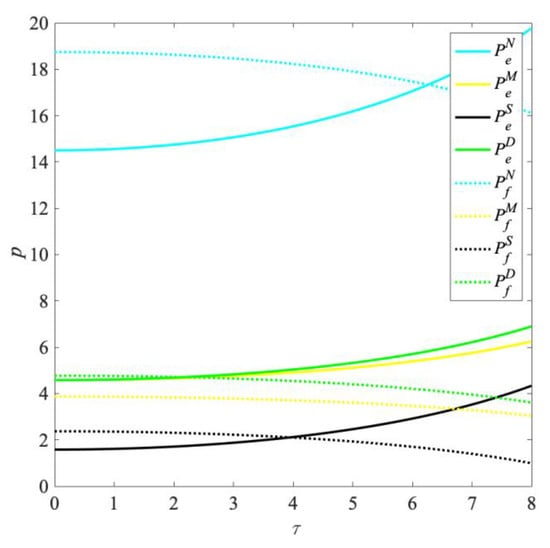
Figure 4.
Effect of consumer environmental awareness on price.
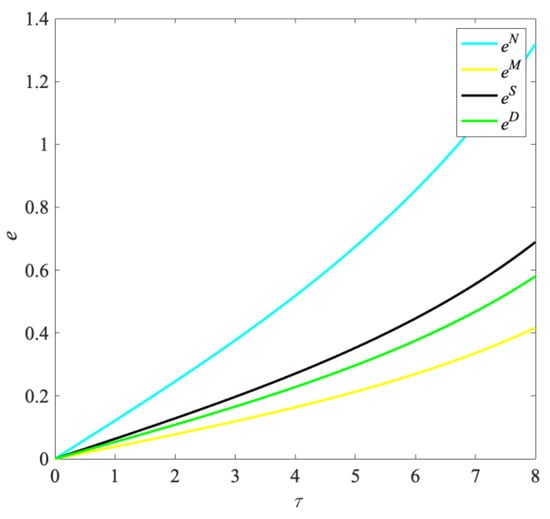
Figure 5.
Effect of consumer environmental awareness on green innovation rate.
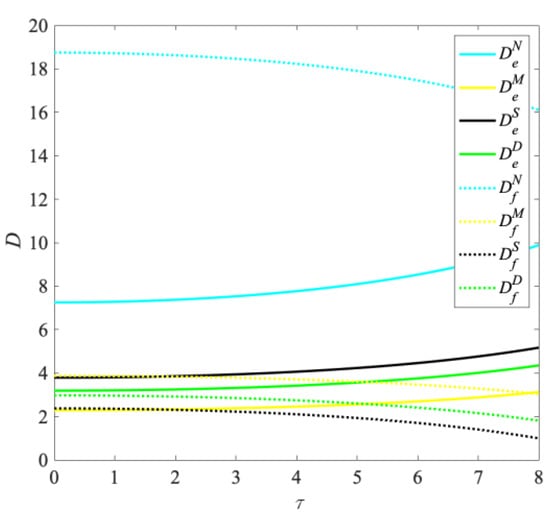
Figure 6.
Effect of the consumer environmental awareness on demands.
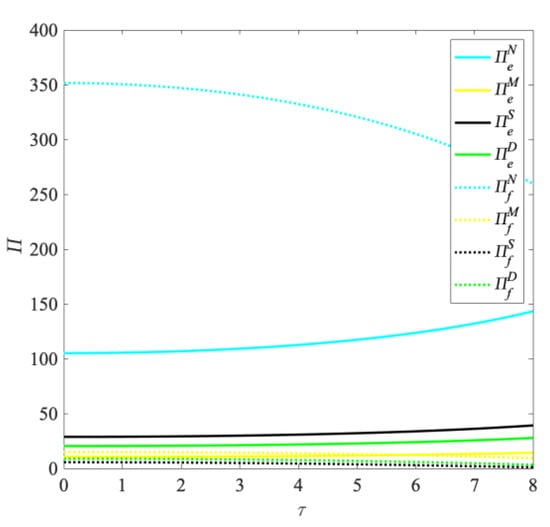
Figure 7.
Effect of the consumer environmental awareness on profits.
Figure 4 shows that, in each of the four scenarios, increasing consumer environmental awareness benefits the price of NEVs. The license plate auction renders the price difference between NEVs and FVs insignificant when consumer environmental awareness is low. The lowest price difference is between NEVs and FVs under the dual-credit policy with license plate auction. The subsidy policy based on license plate auction has the lowest prices for the two automobiles. Moreover, the prices of the license plate auction-only policy are relatively close to the dual-credit policy based on license plate auction; nevertheless, with rising environmental awareness among consumers, their price disparity is increasingly apparent.
Figure 5 shows that growing consumer environmental awareness also helps to increase the green innovation rate of NEVs. In the same way, increased consumer environmental awareness fosters NEVs’ green innovation rate the most in the absence of the license plate auction policy. Further, the level of green innovation rate is at its lowest when only the license plate auction policy is implemented. For this, it is challenging to motivate manufacturers to turn prospective consumer demand for green products into new green innovation drivers using solely restrictive rules. NEV manufacturers may be most motivated to innovate when there is no license plate auction. Under the context of the implementation of the license plate auction policy, the green innovation level of NEV manufacturers under the government subsidy policy is higher than the dual-credit policy. This green innovation distinction continues to grow as consumer awareness of the environment increases.
Figure 6 illustrates that increasing consumer environmental consciousness results in higher demand for NEV and lower demand for FV. The increase in consumer environmental awareness has the greatest impact on consumer car demand when no regulation is in place, but the weakest impact when only the license plate auction policy is implemented. The adoption of a license plate auction policy can successfully reduce the overall demand for automobiles in metropolitan areas. When the license plate auction policy is implemented, the subsidy policy marginally outperforms the dual-credit policy in encouraging the NEV manufacturers, and this difference remains constantly stable as consumer environmental awareness increases.
Figure 7 indicates that consumer environmental awareness is advantageous to the financial performance of NEV manufacturersManufacturers of NEVs and FVs generate the largest profits in the absence of government intervention, and improvements in consumers’ environmental awareness have the greatest impact on this situation. However, as soon as the license plate auction policy is implemented, the manufacturers’ profit falls. Therefore, the increased environmental awareness level of consumers has a minimal impact on the license plate auction policy, subsidy policy based on the license plate auction policy, and dual-credit policy based on the license plate auction policy. In the metropolitan setting, the influence of consumers’ growing environmental consciousness on manufacturers’ profits is not particularly large.
6.2. The License Plate Auction Parameter
Figure 8 and Figure 9 show that the demand for NEVs is less affected by license plate quotas than the demand for FVs. The prices, demands, and profits of FV and NEV manufacturers all exhibit a growing tendency with the rise in the license plate quota, but this increasing trend gradually flattens. Additionally, under the license plate auction policy, subsidy policy based on the license plate auction policy, and dual-credit policy based on the license plate auction policy, the demand and profits of FVs decline in that sequence, whereas the outcomes for NEVs are the exact opposite.
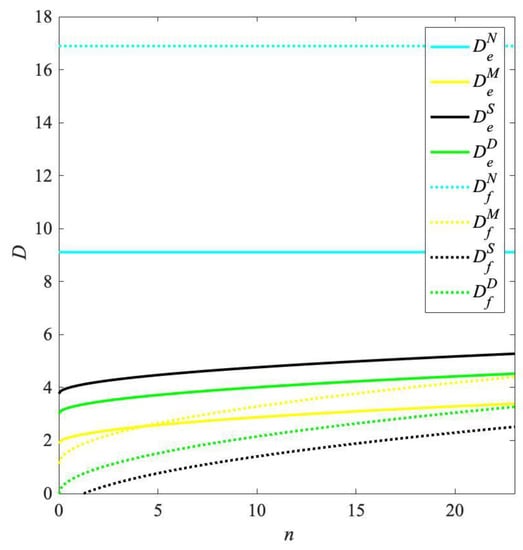
Figure 8.
Effect of license plate auction demands.
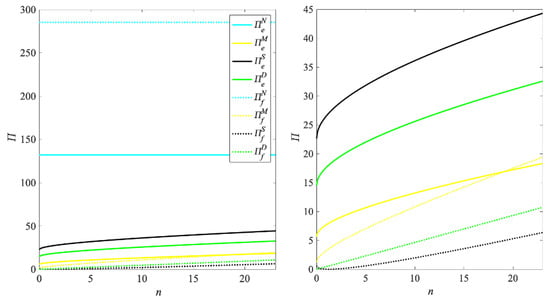
Figure 9.
Effect of license plate auction on profits.
6.3. The Subsidy and License Plate Parameter
Figure 10 displays that both the subsidy policy and the license plate auction policy widen the profit disparity between NEV and FV manufacturers. For FVs, subsidy policy is becoming increasingly less relevant as licensing auction policy become stricter. As a result, the subsidy policy has a more significant impact than the license plate auction policy for NEVs and FVs.
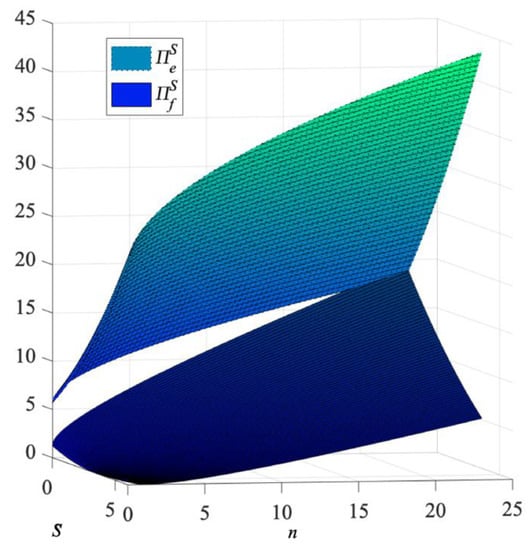
Figure 10.
Effect of subsidy and license plate auction on profits.
6.4. The Credit and License Plate Auction Parameter
Figure 11 demonstrates that for NEV manufacturers, the impact of the credit conversion ratio is significantly greater than that of the license plate auction. Even while the two policies’ primary goal is to reduce the demand for FVs, the stronger the two regulations, the lower the FV profits. Instead, a series of appropriate policy strength matching yields the lowest profit for FV manufacturers.
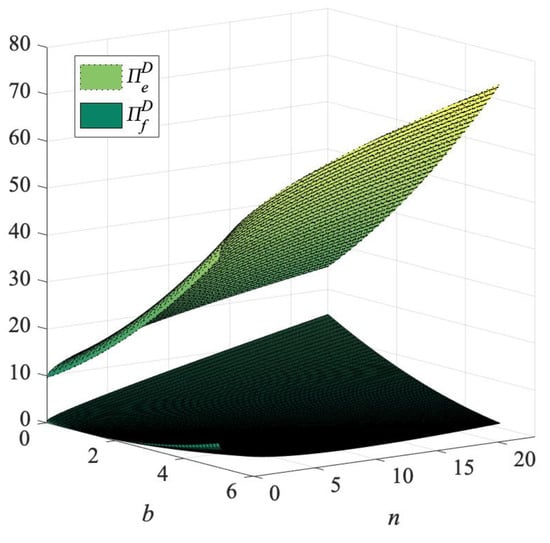
Figure 11.
Effect of license plate auction and credit conversion ratio on manufacturer’s profit.
7. Discussion and Conclusions
This study constructs a competitive game model consisting of a NEV manufacturer and an FV manufacturer, and discusses no government intervention, only license plate auction policy, government subsidy based on license plate auction policy, and dual-credit policy based on license plate auction policy.
First, we used game theory to explore a “market auction” of license plate restriction policy. The majority of those purchasing NEVs, however, reside in big cities. Meanwhile, FVs are typically subject to license plate restrictions in metropolises. Existing studies have explored the impact of the license plate lottery policy on NEVs through empirical methods [10]. However, compared to the license plate lottery policy, the impact of the auction policy on NEVs has not yet been explored. As a result, this study examined NEVs to include the restriction policy of auction bidding. The findings demonstrated that the “market auction” license plate restriction policy can effectively lower the prices, demands, and profits of FVs. Importantly, the license plate auction policy also has an impact on the prices, demands, and profits of NEVs.
Second, most existing research ignores the context of policy implementation and instead only concentrates on the NEV policies. For example, Yang, Lin, Wu, and Chen [20] studied the subsidy policy of NEVs; Li, Zhang, Tang, McLellan, Ye, Shimoda, and Ishihara [22] and Lou, Ma, Fan and Chan [13] conducted a study on the dual-credit policy. In practice, in several big cities of China, license plate restrictions go hand-in-hand with the financial initiatives that are used to promote NEVs. The joint effects of license plate auction policy with subsidy policy and dual-credit policy were, thus, investigated in this study, in contrast to prior studies that have considered subsidy policy and dual-credit policy simultaneously with other policies.
Third, we compared both without and with license plate auction policy. Our findings demonstrated that, regardless of whether the dual-credit or subsidy policies are implemented, it is not possible to reach the production state without the limit on the total number of vehicles, as long as there is a restriction on the growth of vehicles in a major city. Furthermore, the profits made by FV and NEV manufacturers are comparable if the license plate auction policy is in place, regardless of whether the subsidy policy or the dual-credit policy has been implemented, although there may be differences in the sales strategies for profit.
This study concludes with suggestions for further study after discussion of the primary implications of the findings.
For governments considering incentive programs for NEVs, our findings can offer some insightful information. The license plate auction policy for FVs has a detrimental effect on both FVs’ and NEVs’ prices and demands. As a result, the license plate auction policy can be utilized as a practical measure to restrict the usage of automobiles in big cities. Further, no matter the policy it is paired with, the license plate auction policy is effective and can have similar or identical effects. However, if the government seeks to increase the green innovation rate of NEVs, it must also appropriately relax the license plate auction policy on vehicles to activate the vitality of the market. Additionally, when the government enacts the license plate auction policy, the dual-credit policy can still be seen as an innovative and effective government initiative in comparison to the conventional subsidy mechanisms. The dual-credit policy based on license plate auction policy can transfer NEV production incentives from local government to FV automakers, lowering the government’s financial burden. Direct incentive policies for NEVs, however, are more effective at increasing NEV production. Consumers may prefer policies that provide subsidies, and these could be utilized to increase their demand for NEVs. Further, when NEVs more easily overcome the technical bottleneck, the implementation of subsidy policies is also desirable in order to achieve a higher level of green innovation. Finally, in the setting of big cities, consumers’ strong desire for automobiles exceeds the city’s automotive capacity. The manufacturer’s profits are less affected by consumers’ environmental awareness. As a result, NEV manufacturers paying more money for green marketing may have little effect. However, as license plate restrictions are further relaxed, consumers’ environmental awareness should be cultivated accordingly. Increasing consumer environmental awareness will have a significant impact on how NEVs are developed.
There are several possible research directions to consider. First, the license plate auction policy has additional methods to the market auction, such as the policy of participating in the second auction and the policy of not participating in the second auction. However, to determine whether there are different consequences, more research is required. Second, this study primarily focused on the manufacturer’s production strategy, but it did not consider social welfare changes. Third, the purpose of government policy is diverse. Government objectives include social welfare, sustainable development, net revenue, or energy conservation [41]. Thus, to examine the effects of policies, future research should distinguish between various governmental goals.
Author Contributions
Conceptualization, L.T. and X.L.; Methodology, L.T.; Software, L.T.; Validation, L.T. and X.L.; Formal analysis, L.T.; Investigation, L.T.; Data curation, L.T.; Writing—original draft, L.T.; Writing—review & editing, L.T. and X.L.; Visualization, L.T.; Supervision, X.L.; Funding acquisition, X.L. All authors have read and agreed to the published version of the manuscript.
Funding
This research was funded by National Social Science Fund of China (20AZD059).
Data Availability Statement
Not applicable.
Conflicts of Interest
The authors declare no conflict of interest.
Appendix A
Proof of Theorem 1.
The Hessian matrix of the NEV’s profit function is:
In order to find the optimal value, the following conditions need to be met:
Considering the variable assumptions, Equation (A2) are satisfied. So, when , we set the first derivatives of , , and equal to zero. By solving , and , we get the optimal sales price of NEV and FV and the optimal green innovation rate of NEVs.
By substituting , , and into Equations (11) and (12), we obtain:
□
Proof of Theorem 2.
The Hessian matrix of the NEV’s profit function is:
In order to find the optimal value, the following conditions need to be met:
Considering the variable assumptions, Equation (A4) are satisfied. So, when , we set the first derivatives of , , and equal to zero. By solving , and , we get the optimal sales price of NEV and FV and the optimal green innovation rate of NEVs.
By substituting , , and into Equations (16) and (17), we obtain:
□
Proof of Theorem 3.
The Hessian matrix of the NEV’s profit function is:
In order to find the optimal value, the following conditions need to be met:
Considering the variable assumptions, Equation (A6) are satisfied. So, when , we set the first derivatives of , , and equal to zero. By solving , and , we get the optimal sales price of NEV and FV and the optimal green innovation rate of NEVs.
By substituting , , and into Equations (21) and (22), we obtain:
□
Proof of Theorem 4.
The Hessian matrix of the NEV’s profit function is:
In order to find the optimal value, the following conditions need to be met:
Considering the variable assumptions, Equation (A6) are satisfied. So, when , we set the first derivatives of , , and equal to zero. By solving , and , we get the optimal sales price of NEV and FV and the optimal green innovation rate of NEVs.
By substituting , , and into Equations (26) and (27), we obtain:
□
Appendix B
Appendix C
Proof of Proposition 1.
In equilibrium, the first derivatives of the equilibrium value to are:
□
Proof of Proposition 2.
In equilibrium, the first derivatives of the equilibrium value to are:
□
Proof of Proposition 3.
In equilibrium, the first derivatives of the equilibrium value to are:
□
Proof of Proposition 4.
In equilibrium, the first derivatives of the equilibrium value to are:
□
Proof of Proposition 5.
Under the N model, the first derivative of the equilibrium value to is shown in Proof of Proposition 1. The derivatives of the equilibrium values under the other three models are:
□
Proof of Proposition 6.
Under the M model, the first derivative of the equilibrium value to is shown in Proof of Proposition 2. The derivatives of the equilibrium values under the other two models are:
□
References
- Hessing, M.; Summerville, T. Canadian natural Resource and Environmental Policy: Political Economy and Public Policy; UBC Press: Vancouver, BC, Canada, 2014. [Google Scholar]
- Cui, X.; Fang, C.; Liu, H.; Liu, X. Assessing sustainability of urbanization by a coordinated development index for an Urbanization-Resources-Environment complex system: A case study of Jing-Jin-Ji region, China. Ecol. Indic. 2019, 96, 383–391. [Google Scholar] [CrossRef]
- Ministry of Ecology Environment the People’s Republic of China. Annual Report on Environmental Management of Motor Vehicles in China 2021; Ministry of Ecology and Environment the People’s Republic of China: Beijing, China, 2021. [Google Scholar]
- Sun, H.; Geng, Y.; Hu, L.; Shi, L.; Xu, T. Measuring China’s new energy vehicle patents: A social network analysis approach. Energy 2018, 153, 685–693. [Google Scholar] [CrossRef]
- Ji, S.-f.; Zhao, D.; Luo, R.-j. Evolutionary game analysis on local governments and manufacturers’ behavioral strategies: Impact of phasing out subsidies for new energy vehicles. Energy 2019, 189, 116064. [Google Scholar] [CrossRef]
- Ministry of Finance of the People’s Republic of China. The Special Inspection on Subsidies for Alternative Energy Vehicle (AEV) Promotion and Application; Ministry of Finance of the People’s Republic of China: Beijing, China, 2016. [Google Scholar]
- Zhang, L.; Wang, L.; Chai, J. Influence of new energy vehicle subsidy policy on emission reduction of atmospheric pollutants: A case study of Beijing, China. J. Clean. Prod. 2020, 275, 124069. [Google Scholar] [CrossRef]
- Zhang, H.; Cai, G. Subsidy strategy on new-energy vehicle based on incomplete information: A Case in China. Phys. A Stat. Mech. Its Appl. 2020, 541, 123370. [Google Scholar] [CrossRef]
- Li, J.; Ku, Y.; Liu, C.; Zhou, Y. Dual credit policy: Promoting new energy vehicles with battery recycling in a competitive environment? J. Clean. Prod. 2020, 243, 118456. [Google Scholar] [CrossRef]
- Zhang, X.; Bai, X.; Zhong, H. Electric vehicle adoption in license plate-controlled big cities: Evidence from Beijing. J. Clean. Prod. 2018, 202, 191–196. [Google Scholar] [CrossRef]
- Zhao, R.; Neighbour, G.; Han, J.; McGuire, M.; Deutz, P. Using game theory to describe strategy selection for environmental risk and carbon emissions reduction in the green supply chain. J. Loss Prev. Process Ind. 2012, 25, 927–936. [Google Scholar] [CrossRef]
- Zhao, R.; Neighbour, G.; McGuire, M.; Deutz, P. A software based simulation for cleaner production: A game between manufacturers and government. J. Loss Prev. Process Ind. 2013, 26, 59–67. [Google Scholar] [CrossRef]
- Lou, G.; Ma, H.; Fan, T.; Chan, H.K. Impact of the dual-credit policy on improvements in fuel economy and the production of internal combustion engine vehicles. Resour. Conserv. Recycl. 2020, 156, 104712. [Google Scholar] [CrossRef]
- Chen, X.; Zhao, J. Bidding to drive: Car license auction policy in Shanghai and its public acceptance. Transp. Policy 2013, 27, 39–52. [Google Scholar] [CrossRef]
- Huang, J.; Leng, M.; Liang, L.; Liu, J. Promoting electric automobiles: Supply chain analysis under a government’s subsidy incentive scheme. IIE Trans. 2013, 45, 826–844. [Google Scholar] [CrossRef]
- Wang, Z.; Zhao, C.; Yin, J.; Zhang, B. Purchasing intentions of Chinese citizens on new energy vehicles: How should one respond to current preferential policy? J. Clean. Prod. 2017, 161, 1000–1010. [Google Scholar] [CrossRef]
- Shao, L.; Yang, J.; Zhang, M. Subsidy scheme or price discount scheme? Mass adoption of electric vehicles under different market structures. Eur. J. Oper. Res. 2017, 262, 1181–1195. [Google Scholar]
- Thiel, C.; Perujo, A.; Mercier, A. Cost and CO2 aspects of future vehicle options in Europe under new energy policy scenarios. Energy Policy 2010, 38, 7142–7151. [Google Scholar] [CrossRef]
- Yang, D.; Qiu, L.; Yan, J.; Chen, Z.; Jiang, M. The government regulation and market behavior of the new energy automotive industry. J. Clean. Prod. 2019, 210, 1281–1288. [Google Scholar] [CrossRef]
- Yang, J.; Lin, Y.; Wu, F.; Chen, L. Subsidy and pricing model of electric vehicle sharing based on two-stage Stackelberg game–a case study in China. Appl. Sci. 2019, 9, 1631. [Google Scholar] [CrossRef]
- Chen, K.; Zhao, F.; Hao, H.; Liu, Z. Synergistic impacts of China’s subsidy policy and new energy vehicle credit regulation on the technological development of battery electric vehicles. Energies 2018, 11, 3193. [Google Scholar] [CrossRef]
- Li, Y.; Zhang, Q.; Tang, Y.; McLellan, B.; Ye, H.; Shimoda, H.; Ishihara, K. Dynamic optimization management of the dual-credit policy for passenger vehicles. J. Clean. Prod. 2020, 249, 119384. [Google Scholar] [CrossRef]
- Li, J.; Ku, Y.; Yu, Y.; Liu, C.; Zhou, Y. Optimizing production of new energy vehicles with across-chain cooperation under China’s dual credit policy. Energy 2020, 194, 116832. [Google Scholar] [CrossRef]
- Cheng, Y.; Fan, T. Production coopetition strategies for an FV automaker and a competitive NEV automaker under the dual-credit policy. Omega 2021, 103, 102391. [Google Scholar] [CrossRef]
- Tan, L.H. Rationing rules and outcomes: The experience of Singapore’s vehicle quota system. IMF Staff Papers 2003, 50, 436–457. [Google Scholar] [CrossRef]
- Yang, J.; Liu, Y.; Qin, P.; Liu, A.A. A review of Beijing’s vehicle registration lottery: Short-term effects on vehicle growth and fuel consumption. Energy Policy 2014, 75, 157–166. [Google Scholar] [CrossRef]
- Yang, J.; Liu, A.; Qin, P.; Linn, J. The effect of owning a car on travel behavior: Evidence from the Beijing license plate lottery. Resour. Future Discuss. Pap. 2016, 16–18. [Google Scholar] [CrossRef]
- Xiao, J.; Zhou, X.; Hu, W.-M. Welfare analysis of the vehicle quota system in China. Int. Econ. Rev. 2017, 58, 617–650. [Google Scholar] [CrossRef]
- Aumann, R.J. Presidential address at the First International Congress of the Game Theory Society. Games Econ. Behav. 2003, 45, 2–14. [Google Scholar] [CrossRef]
- Peng, L.; Li, Y.; Yu, H. Effects of Dual Credit Policy and Consumer Preferences on Production Decisions in Automobile Supply Chain. Sustainability 2021, 13, 5821. [Google Scholar] [CrossRef]
- Ma, H.; Lou, G.; Fan, T.; Chan, H.K.; Chung, S.H. Conventional automotive supply chains under China’s dual-credit policy: Fuel economy, production and coordination. Energy Policy 2021, 151, 112166. [Google Scholar] [CrossRef]
- Li, Y.; Zhang, Q.; Liu, B.; McLellan, B.; Gao, Y.; Tang, Y. Substitution effect of new-energy vehicle credit program and corporate average fuel consumption regulation for green-car subsidy. Energy 2018, 152, 223–236. [Google Scholar] [CrossRef]
- Dong, Z.; He, Y.; Wang, H. Dynamic effect retest of R&D subsidies policies of China’s auto industry on directed technological change and environmental quality. J. Clean. Prod. 2019, 231, 196–206. [Google Scholar]
- Choi, S.C. Price competition in a duopoly common retailer channel. J. Retail. 1996, 72, 117–134. [Google Scholar] [CrossRef]
- Liu, Z.L.; Anderson, T.D.; Cruz, J.M. Consumer environmental awareness and competition in two-stage supply chains. Eur. J. Oper. Res. 2012, 218, 602–613. [Google Scholar] [CrossRef]
- Tsay, A.A.; Agrawal, N. Channel dynamics under price and service competition. Manuf. Serv. Oper. Manag. 2000, 2, 372–391. [Google Scholar] [CrossRef]
- Swami, S.; Shah, J. Channel coordination in green supply chain management. J. Oper. Res. Soc. 2013, 64, 336–351. [Google Scholar] [CrossRef]
- Che, Y.-K.; Gale, I.; Kim, J. Efficient assignment mechanisms for liquidity-constrained agents. Int. J. Ind. Organ. 2013, 31, 659–665. [Google Scholar] [CrossRef]
- Ma, S.-C.; Fan, Y.; Feng, L. An evaluation of government incentives for new energy vehicles in China focusing on vehicle purchasing restrictions. Energy Policy 2017, 110, 609–618. [Google Scholar] [CrossRef]
- Meng, Q.; Wang, Y.; Zhang, Z.; He, Y. Supply chain green innovation subsidy strategy considering consumer heterogeneity. J. Clean. Prod. 2021, 281, 125199. [Google Scholar] [CrossRef]
- Hafezalkotob, A. Competition, cooperation, and coopetition of green supply chains under regulations on energy saving levels. Transp. Res. Part E Logist. Transp. Rev. 2017, 97, 228–250. [Google Scholar] [CrossRef]
Disclaimer/Publisher’s Note: The statements, opinions and data contained in all publications are solely those of the individual author(s) and contributor(s) and not of MDPI and/or the editor(s). MDPI and/or the editor(s) disclaim responsibility for any injury to people or property resulting from any ideas, methods, instructions or products referred to in the content. |
© 2023 by the authors. Licensee MDPI, Basel, Switzerland. This article is an open access article distributed under the terms and conditions of the Creative Commons Attribution (CC BY) license (https://creativecommons.org/licenses/by/4.0/).